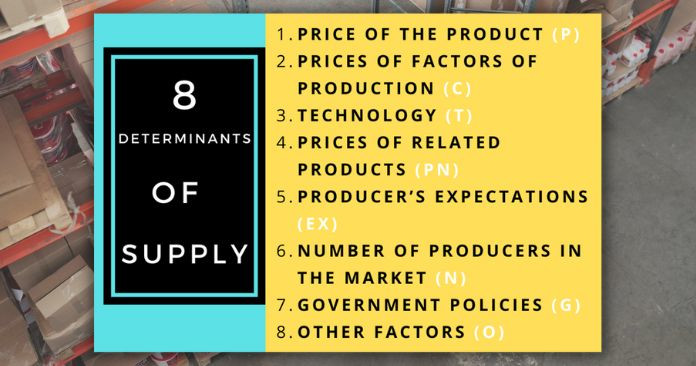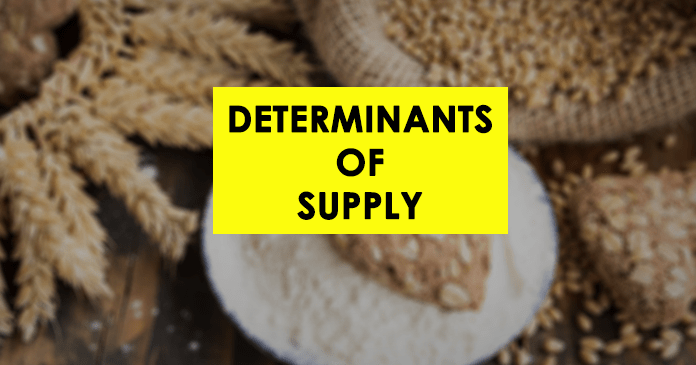There are a number of factors that influence the quantity that producers plan to supply to the market at a given time. Determinants of supply are as follows.
- Price of the product (P)
- Prices of factors of production (C)
- Technology (T)
- Prices of related products (Pn)
- Producer’s expectations (Ex)
- Number of producers in the market (N)
- Government Policies (G)
- Other factors (O)
Let’s discuss the factors one by one. First of all, we need to create the supply function. A supply function can write by identifying the quantity of goods supplied as the dependent variable and the factors mentioned above as independent variables that affect it.
Supply Function
Qs = f (P, C, T, Pn, Ex, N, G, O)
In this function, let us consider how the quantity of supply is determined by the independent variables other than the price of the item under consideration.

Prices of factors of production (C)
The supply curve of an institution is the curve that expresses the minimum price at which the producer willing to supply the product.
As the price of the factors of production increases, the minimum price that the producer willing to provide also increases. So the supply decreases and the supply curve shifts to the left.
For example, seeds of the cacao tree use to made chocolate. If cacao seed prices increased, the cost of producing chocolate increase as well. As a result of that supply decreases.
Determinants of Supply: Technology (T)
Technology refers to the methodology by which resources are used to produce goods. Production costs go down if more efficient techniques are found and used to produce a product.
As a result of that the supply increases and the supply curve shifts to the right. Technological improvements help reduce production cost and increase profit as well.
Prices of related products (Pn)
The prices of goods and substitutes goods produced by a firm affect the supply of the relevant product. It means, If another good that a firm could produce rises in price, firms will produce more of it and less of what they used to produce.
Goods that can be produced using the same resources are called substitute goods in the production process.
For example, when the price of green gram is relatively high, the land used for maize cultivation can be used for green gram cultivation. Then the supply of corn decreases.
Determinants of Supply: Producer’s expectations (Ex)
Changes in the expectations of the producers affect the current supply of the product. It is not clear how price expectations will affect the current supply as it will vary depending on the nature of the goods.
For example, producers are expanding their supply, thinking that the future price of industrial products will be higher.
Expectations of a change in any factor affecting future profitability affect current supply. Expectations of business tax and import restrictions are some examples.
Number of producers in the market (N)
The number of suppliers in the market also affects the supply of the market. When the number of suppliers increases, the supply increases and when the number of suppliers decreases, the supply decreases.
Determinants of Supply: Government Policies (G)
Government policies can be pointed as a determinant of supply. Various regulations, taxes and production subsidies impose by the government also affect the supply. For example, taxes on goods will increase the marginal cost of production. On the other hand, Production subsidies will reduce marginal costs. Thus the minimum price at which the goods are to be supplied is also increased or decreased.
Determinants of Supply: Other factors (O)
Under this, changes in supply due to the influence of nature and the Internet can be pointed out. Disasters, such as epidemics, droughts, and floods, cause changes in supply.


